Parkside HG04718 Bedienungsanleitung
Parkside
Nicht kategorisiert
HG04718
Lies die bedienungsanleitung für Parkside HG04718 (2 Seiten) kostenlos online; sie gehört zur Kategorie Nicht kategorisiert. Dieses Handbuch wurde von 43 Personen als hilfreich bewertet und erhielt im Schnitt 4.9 Sterne aus 22 Bewertungen. Hast du eine Frage zu Parkside HG04718 oder möchtest du andere Nutzer dieses Produkts befragen? Stelle eine Frage
Seite 1/2

GB/MT GB/MT GB/MT GB/MT GB/MT GB/MT
Meaning of symbols
Not approved for hand-held or
manually-guided grinding
Not approved for wet grinding
Not approved for side grinding
Do not use if damaged
Only approved with a backing pad
Only approved for wet cutting
Heed all safety instructions
Use protective eyewear
Wear a safety helmet
Use ear protection
Wear safety gloves
Use a dust mask
Unplug
Only for roughing / Only for
grinding
Not for roughing
Only for cutting
Not for cutting
Not approved for working with
metals
Safety instructions for steel brushes
Please note that steel brushes lose steel pieces during normal use. Do not
apply too much pressure to steel brushes. Failure to heed this warning may lead to
injury due to flying steel pieces.
When the use of a safety cover is recommended, prevent the safety cover and steel brush from
coming into contact with one another. Please note that the diameter of disk brushes and cup
brushes can increases due to pressure and centrifugal force.
Installation (HG04719)
Cutting disc
Mounting flange
Safety guard
Grinder spindle
* Machine is not
included.
Clamping nut
Support boards and large
workpieces to prevent the risk of
kickback due to a jammed cutting
disk. Large workpieces may bend due to
their own weight. Support large workpieces
on both ends and near the cutting site.
Exercise extreme caution when
cutting into existing walls and other
areas where vision is limited. Your
cutting disk may kickback if it comes into
contact with gas, water and electrical lines
or other objects.
After cutting for 60 to 80 seconds, the
machine must be left running idle for 10
seconds to prevent the cutting discs from
overheating.
When using this diamond cutting disc, the
following instructions must be observed:
– Always attach discs clear of radial and
axial run-out.
– Keep to the ideal rotation speed as per
manufacturer’s specifications.
– Clamp the material firmly before starting
to cut.
– Do not move the blade back and forth
through the material; progress through it
steadily in one cut.
– Do not exert excessive pressure, the
weight of the machine is sufficient.
– Always wear protective headgear.
– Let the blade cool down at regular
intervals.
Safety instructions for grinding
with sandpaper
Heed the manufacturer’s instructions for all
sanding sheet sizes. Do not use sanding
sheets that are too large. Sanding sheets
that extend over the disk can lead to injury
and blocking. The sanding sheet may also
tear, causing kickback.
Always use undamaged clamping
flanges of the right size and
proper form for the grinding disk
you’ve selected for use. The right
flange supports the grinding disk and thus
minimizes the risk of it breaking. Flanges
for cutting disks may differ from flanges for
grinding disks.
Safety instructions for cut-off
grinding
Avoid your cutting disk from
blocking and do not apply too much
pressure. Overstressing the cutting
disk increases its risk of jamming or
blocking and thus the likelihood of kickback
or damage to the attachment itself.
Avoid the area directly in front of
and behind the rotating cutting
disk. When moving the cutting disk across
your workpiece away from your person, the
tool may be hurled in your direction in the
event of kickback.
Turn off the device is the cutting
disk jams or if you wish to interrupt
working. Hold the device calmly and
allow all rotating parts to come to a
complete stop. Never attempt to pull any
rotating parts from the cutting site. This may
cause kickback.
Do not turn on the device while it
is still in the workpiece. Your cutting
disk should reach its full speed before you
continue angle grinding. Otherwise the disk
may jam, jump back from the workpiece and
cause kickback.
Exercise extreme caution when
working on corners, sharp edges,
etc. Prevent your tool attachments
from jumping back from the
workpiece and jamming. The rotating
tool attachment tends to jam when working
on corners, sharp edges or when it jumps
back from the workpiece. This leads to loss
of control or kickback.
Safety instructions for grinding and
cut-off grinding
Only use grinding wheels that are
approved for use with your power
tool and the proper safety cover.
Grinding wheels not approved for use
with your power tool may not be shielded
sufficiently and are therefore unsafe for use.
The safety cover must be attached
to the power tool and adjusted
so that maximum safety is
guaranteed, that is, as little of the
grinding wheel as possible is open
toward the operating individual.
The purpose of the safety cover is to shield
the operating individual from broken pieces
or accidental contact to the grinding wheel.
Grinding wheels may be used only
for their intended purpose. For
example, never grind using the side of a
cutting disk. Cutting disks are intended to cut
materials using the disk edge only. Applying
pressure to the side of the disk may cause it
to break.
Keep the power cable away from all rotating
tool attachments. If you lose control of the
device, the power cable may be severed or
caught, causing the rotating attachment to
come into contact with your hand or arm.
Allow all tool attachments to come to a
complete stop before setting down your
power tool. Rotating attachments may come
into contact with the surface. This may
cause you to lose control of the power tool,
leading to injury of yourself or others.
Turn off the power tool when carrying it
about. Your clothing may otherwise become
tangled up in the rotating attachment,
causing personal injury.
Do not use the power tool near flammable
materials. Sparks may ignite such materials.
Kickback and related safety
instructions
Kickback is a sudden reaction arising when
a rotating power tool attachment, such as a
grinding disk, buffing disk, wire brush, etc., snags
or jams.
Kickback is the result of improper use of
the power tool. Heed the following safety
precautions to prevent kickback:
Always maintain a firm grip on the power
tool and use any available additional
handle to better control kickback.
Keep your hands away from
rotating tool attachments at all
times. The attachment may come into
contact with your hand in case of kickback.
Keep your body out of the area that
the power tool would enter in case
of kickback.
In case of kickback, your power tool will
jump in the direction opposite to that in
which the grinding disk is moving.
IT/MT
IT/MT
IT/MT
IT/MT
GB/MT
IT/MT
IT/MT
GB/MT
IT/MT
IT/MT
GB/MT
IT/MT
IT/MT
GB/MT
IT/MT
IT/MT
GB/MT
Istruzioni per l‘uso
SET MOLE DIAMANTATE
(HG04716) /
SPAZZOLA A TAZZA
(HG04717) /
SET DISCHI ABRASIVI-DISCO A
STRAPPO (HG04718) /
SET MOLE DA TAGLIO
(HG04719)
Introduzione
Congratulazioni per l‘acquisto del vostro nuovo
prodotto. Con esso avete optato per un prodotto
di qualità. Familiarizzare con il prodotto prima
di metterlo in funzione per la prima volta. A
tale scopo, leggere attentamente le seguenti
istruzioni d‘uso e le avvertenze di sicurezza.
Utilizzare il prodotto solo come descritto e per
i campi di applicazione indicati. Conservare
queste istruzioni in un luogo sicuro. Consegnare
tutta la documentazione in caso di cessione del
prodotto a terzi.
Destinazione d‘uso
Il prodotto non è destinato all‘uso commerciale.
Accessori Impieghi
Set mole diamantate HG04716
Disco a bordo pieno Taglio a umido di ceramiche, piastrelle, lastre di
marmo, granito sottile o materiali simili.
Disco segmentato Taglio a secco di calcestruzzo, tegole, mattoni o
materiali simili.
Disco turbo Taglio universale a secco/umido.
Spazzola a tazza HG04717 Rimozione di ruggine, vernice o pittura.
Set dischi abrasivi-disco a
strappo
HG04718 Rettifica del legno e rimozione di ruggine dal
metallo.
Set mole da taglio HG04719 Taglio di metalli.
Tenere il cavo di rete a dovuta distanza
dagli utensili di inserimento rotanti. In caso
di perdita di controllo dell’apparecchiatura,
il cavo di rete può essere tagliato in due o
colpito e la mano o il braccio dell’operatore
potrebbero finire nell’attrezzatura
d’inserimento in rotazione.
Prima di depositare l’elettroutensile,
attendere che l’attrezzo di inserimento sia
completamente in arresto. L’elettroutensile
ruotante può venire a contatto con la
superficie di sostegno, così l‘operatore
potrebbe perdere il controllo dell’attrezzo
elettrico e in un modo o nell’altro ferirsi.
Spegnere l’elettroutensile durante il
trasporto. I vestiti potrebbero altrimenti
venire a contatto con l’attrezzatura di
inserimento in rotazione causando ferite.
Non utilizzare l’elettroutensile vicino
a materiali infiammabili. Le schegge
potrebbero infiammare questi materiali.
Contraccolpo e rispettive istruzioni
di sicurezza
Il contraccolpo è una reazione causata da un
attrezzo di inserimento ruotante impigliato o
bloccato, quale ad es. disco abrasivo, piatto
abrasivo, spazzola di metallo ecc. È il risultato di
un utilizzo erroneo o scorretto dell’elettroutensile
e può essere evitato attenendosi alle seguenti
precauzioni:
Tenere l’elettroutensile ben fisso e, se
presente, usare sempre un’impugnatura
aggiuntiva per poter controllare meglio il
contraccolpo.
Non tenere mai la mano vicino agli
attrezzi di inserimento in rotazione.
L’attrezzo di inserimento può altrimenti
passare sulla mano al momento del
contraccolpo.
Evitare di avvicinarsi con il proprio
corpo alla zona del contraccolpo
dell’elettroutensile. Il contraccolpo
muove l’elettroutensile nella direzione
opposta rispetto al movimenti del disco
abrasivo sul punto di blocco.
CAUTELA! Rispettare le istruzioni di
sicurezza.
Calcestruzzo /
tegole / muratura
Marmo /
piastrelle /
non adatto per
l’acciaio
Smaltimento
L’imballaggio è composto da materiali ecologici
che possono essere smaltiti presso i siti di
raccolta locali per il riciclo.
E’ possibile informarsi circa le possibilità
di smaltimento del prodotto usato presso
l’amministrazione comunale o cittadina.
Assistenza
Assistenza Italia
Tel.: 800790789
E-Mail: owim@lidl.it
Assistenza Malta
Tel.: 80062960
E-Mail: owim@lidl.com.mt
Lavorare con particolare attenzione
in prossimità di angoli, spigoli
taglienti, ecc. Impedire che gli
attrezzi di inserimento rimbalzino
dal pezzo in lavorazione o si
blocchino. L’utensile in rotazione tende a
bloccarsi in angoli, spigoli taglienti o in caso
di rimbalzi. Ciò provoca un contraccolpo o
una perdita di controllo.
Istruzioni di sicurezza per
levigatura e troncatura
Utilizzare esclusivamente utensili
abrasivi idonei all’elettroutensile
in dotazione e la rispettiva cuffia
di protezione. Utensili abrasivi non
idonei all’elettroutensile non possono essere
sufficientemente schermati e non sono
pertanto sicuri.
La cuffia di protezione deve
essere applicata con sicurezza
all’elettroutensile e regolata in
modo tale da garantire la massima
sicurezza, la parte dell’utensile
abrasivo va quindi rivolta verso
l’operatore. La cuffia di protezione
protegge l’operatore da frammenti e da
contatti accidentali con l’utensile abrasivo.
Gli utensili abrasivi devono
essere utilizzati esclusivamente
per le applicazioni consigliate.
Ad esempio non eseguire mai
operazioni di levigatura con la
superficie laterale di un disco
abrasivo da taglio dritto. I dischi
abrasivi da taglio dirtto sono adatti per
l’asportazione di materiale con il bordo del
disco. Esercitando carichi laterali su questi
utensili abrasivi si può causare la rottura.
User manual
DIAMOND CUTTING DISC SET
(HG04716) /
WIRE CUP BRUSH (HG04717) /
HOOK & LOOP FIBRE SANDING
DISC SET (HG04718) /
CUTTING DISC SET (HG04719)
Introduction
We congratulate you on the purchase of your
new product. You have chosen a high quality
product. Familiarise yourself with the product
before using it for the first time. In addition,
please carefully refer to the operating instructions
and the safety advice below. Only use the
product as instructed and only for the indicated
field of application. Keep these instructions in a
safe place. If you pass the product on to anyone
else, please ensure that you also pass on all the
documentation with it.
Intended use
This product is not intended for commercial use.
Accessory Applications
Diamond cutting disc set HG04716
Full edge disc Wet cutting ceramics, tiles, marble slabs, thin
granite or similar material.
Segment disc Dry cutting concrete, roofing tiles, bricks or
similar material.
Turbo disc Universal wet/dry cutting.
Wire cup brush HG04717 Removing rust, varnish or paint.
Hook & loop fibre sanding
disc set
HG04718 Sanding wood and removing rust from metal.
Cutting disc set HG04719 Cutting metal.
PRIMA DI USARE L’APPARECCHIO PER LA
PRIMA VOLTA, FAMILIARIZZARE CON TUTTE
LE INDICAZIONI D‘USO E DI SICUREZZA.
IN CASO DI PASSAGGIO DEL PRODOTTO
A TERZI, CONSEGNARE ANCHE TUTTA
LA DOCUMENTAZIONE RELATIVA.
CONSERVARE TUTTE LE INDICAZIONI
DI SICUREZZA E DISPOSIZIONI PER
EVENTUALI NECESSITÀ FUTURE!
Istruzioni di sicurezza
Istruzioni generali di sicurezza per
utensili di rettifica e lucidatura,
driver pad, dischi da taglio e
spazzole a tazza
Gli utensili di molatura sono fragili. È
strettamente necessario usare la massima
cura nel maneggiare gli utensili.
Prima dell‘uso, controllare eventuali danni
sugli utensili di molatura e sulle spazzole.
Non utilizzare utensili di molatura e
spazzole danneggiati, inseriti o meglio
applicati male.
Gli utensili di rettifica non possono essere
utilizzati dopo la data di scadenza. La data
valida è indicata sugli utensili (tranne la
carta vetrata)
Selezionare utensili di rettifica e
lucidatura, driver pad, dischi da
taglio e spazzole a tazza per un
appoggio sicuro e un uso corretto
Attenersi alle avvertenze di sicurezza e alle
limitazioni d’uso o alle istruzioni riguardanti
gli utensili di molatura.
Conservare utensili di rettifica e
lucidatura, driver pad, dischi da
taglio e spazzole a tazza
Maneggiare e trasportare con cura gli
utensili di molatura
Nel depositare gli utensili di molatura, far in
modo che essi non vengano esposti a danni
meccanici o ad agenti atmosferici (p.es.
umidità).
Usare sempre flange di serraggio
in perfetto stato, della giusta
dimensione e forma per la mola
abrasiva selezionata. Le flange adatte
fungono supporto per la mola abrasiva e
riducono quindi il pericolo di rottura della
mola abrasiva. È possibile che via sia una
differenza tra flange per mole abrasive da
taglio dritto e flange per mole abrasive di
altro tipo.
Istruzioni di sicurezza per
troncatura
Evitare di far bloccare il disco
abrasivo da taglio dritto o di
esercitare una pressione troppo
forte. Non eseguire tagli troppo
profondi. Sottoponendo la mola da taglio
dritto a carico eccessivo, se non aumenta
la sollecitazione la si rende soggetta ad
angolature improprie o a blocchi, crendo
così pericolo di contraccolpo o di rottura
dell’utensile abrasivo.
Evitare di avvicinarsi alla zona
anteriore o posteriore del disco
abrasivo da taglio dritto in
rotazione. Manovrando la mola da
taglio dritto nel pezzo di lavorazione in
direzione opposta all’operatore, in caso di
contraccolpo, il disco in rotazione potrebbe
scagliare direttamente l’utensile verso
l’operatore.
Spegnere l’utensile nel caso in cui
il disco abrasivo da taglio dritto
dovesse incepparsi, oppure per
interrompere il lavoro. Tenere l’utensile
fermo fino a quando il disco si sarà fermato
completamente. Non tentare mai di estrarre
il disco abrasivo dal taglio in esecuzione
perchè potrebbe provocare un contraccolpo.
Non riaccendere l’utensile elettrico
finchè si trova ancora nel pezzo
in lavorazione. Attendere che il disco
abrasivo abbia raggiunto la massima
velocità prima di continuare ad eseguire il
taglio. In caso contrario è possibile che il
disco rimanga agganciato, sbalzi dal pezzo
in lavorazione o provochi un contraccolpo.
BEFORE FIRST USE, FAMILIARIZE YOURSELF
WITH THE PRODUCT’S INSTRUCTIONS FOR
USE AND SAFETY INSTRUCTIONS! IF YOU
GIVE THE PRODUCT TO A THIRD PARTY,
YOU MUST INCLUDE ALL DOCUMENTS.
SAVE ALL SAFETY INSTRUCTIONS AND
INSTRUCTIONS FOR USE FOR FUTURE
REFERENCE!
Safety instructions
General safety instructions for
coated grinding and buffing tools,
driver pads, cutting discs and cup
brushes
Grinding/buffing tools are prone to
breakage. Exercise extreme care when
handling grinding/buffing tools.
Check grinding/buffing tools and brushes
for damages before use. Do not use any
damaged tools or incorrectly assembled
grinding/buffing tools or brushes.
Grinding tools are not allow to be use after
the expiration date. The valid date is show
on the tools (except sand papers).
Selecting coated grinding and
buffing tools, driver pads, cutting
discs and cup brushes for secure
footing and proper use
Heed all safety instructions belonging to the
grinding/buffing tools as well as the notes
on proper use or safety instructions.
Storing coated grinding and
buffing tools, driver pads, cutting
discs and cup brushes
Handle and transport grinding/buffing tools
with care.
Store grinding/buffing tools so that they
are not exposed to mechanical stress
or damaging environmental factors
(i.e.moisture).
Nel depositare le spazzole, proteggerle dai
seguenti agenti atmosferici:
Umidità atmosferica elevata, caldo,
acqua (o altri liquidi), acidi o vapori.
Nel depositare le spazzole in ambienti
a temperatura più elevata, evitare sbalzi
di temperatura che potrebbero causare
condensazione.
Deformazione di un componente delle
spazzole.
Prima di utilizzare utensili di
rettifica e lucidatura, driver pad,
dischi da taglio e spazzole a tazza
Prima di qualsiasi utilizzo sottoporre gli
utensili di molatura a una prova di sicurezza.
Non utilizzare utensili o spazzole
danneggiati.
Cambiamenti di colore dovuti alla ruggine
o altri segni di cambiamento di tipo chimico
o meccanico sulle setole potrebbero
provocare un danneggiamento precoce
della spazzola.
È vietato montare spazzole e utensili di
molatura su macchine il cui numero di giri
è superiore a quello massimo indicato sulle
spazzole e sugli utensili di molatura.
Prima dell’uso, si prega di studiare
il manuale della propria macchina
smerigliatrice.
Rimuovere il coperchio di sicurezza prima di
utilizzare le spazzole a tazza e il pile.
Guida all‘apertura
Aprire utensili di molatura e spazzole in
conformità con le linee guida dei produttori
di utensili da molatura e spazzole.
Usare spazzole e utensili di molatura solo su
apparecchi con ricezione adatta.
Dopo ogni apertura effettuare una breve
prova di funzionamento. Non superare la
velocità massima di lavorazione (numero di
giri) indicata sugli utensili di molatura o sulle
spazzole.
Dotare di un supporto adatto
i pannelli oppure i pezzi in
lavorazione in modo da ridurre il
rischio di un contraccolpo dovuto
ad un disco abrasivo da taglio
diritto che rimane bloccato. Pezzi
in lavorazione possono piegarsi sotto
l’effetto del proprio peso. Munire il pezzo
in lavorazione di supporti adatti al caso
specifico, sia nelle vicinanze del taglio di
troncatura che in quelle del bordo.
Operare con particolare cautela
in caso di “tagli dal centro“ da
eseguire in pareti già esistenti
oppure in altri parti non visibili. Il
disco abrasivo da taglio diritto che inizia
il taglio sul materiale può provocare un
contraccolpo se dovesse arrivare a troncare
condutture del gas o dell’acqua, linee
elettriche oppure oggetti di altro tipo.
Dopo 60-80 secondi in modalità di rettifica,
la macchina deve funzionare a vuoto per
10 secondi per evitare il surriscaldamento
dei dischi da taglio.
Con l‘utilizzo di mole da taglio diamantate
bisogna assolutamente osservare le seguenti
indicazioni:
– Fissare i dischi sempre con accuratezza
per evitare oscillazioni.
– Rispettare il numero di giri indicato dal
fornitore.
– Bloccare il materiale da tagliare.
– Non passare più volte i dischi sul
materiale, passare una sola volta senza
interruzioni.
– Non esercitare forti pressioni; il peso della
macchina è sufficiente.
– Indossare sempre il casco di protezione.
– Fare delle pause per lasciar raffreddare
il disco.
Avvertenze di sicurezza per
levigatura con carta vetrata
Attenersi alle indicazioni del produttore
relative alle dimensioni dei fogli abrasivi.
Non utilizzare mai fogli abrasivi troppo
grandi. Fogli abrasivi che dovessero
sporgere oltre il platorello possono
provocare incidenti, blocchi, strappi dei fogli
abrasivi oppure contraccolpi.
Store brushes so that they are shielded from
the following:
High humidity, heat, water (or other
liquids), acids or vapours. Also avoid low
temperatures which may cause condensation
to form on the brushes when they are moved
to spaces with a higher temperature.
Deformation of a brush component.
Before using coated grinding and
buffing tools, driver pads, cutting
discs and cup brushes
Always check grinding/buffing tools for
damages before use.
Do not use any damaged grinding/buffing
tools or brushes.
Rust build-up or other signs of chemical
or mechanical alteration to the fitting
equipment of brushes may cause premature
failure of the tool.
Brushes and grinding/buffing tools may
not be mounted to machines whose speed
exceeds the maximum speed of the brush or
grinding/buffing tool.
Before use, please study the manual of your
grinder machine.
Remove the safety cover before using the
cup brushes and the fleece.
Instructions for mounting
Following the instructions included with
the grinding/buffing tool and those of the
machine manufacturer to mount grinding/
buffing tools and brushes.
Make sure to use brushes and grinding/
buffing tools only with devices that have an
appropriate tool attachment.
After mounting, always do a small test run.
Do not exceed the maximum labelled speed
of the grinding/buffing tool or brush.
Esercizio delle operazioni
di molatura/troncatura (se
pertinente)
Rispettare le indicazioni di utilizzo del
produttore di elettroutensili.
Installare tutte le protezioni prima
dell’avviamento della macchina.
Indossare attrezzature di sicurezza in
conformità con il tipo di macchina e
d‘uso, ad. es. occhiali protettivi, maschere
protettive, cuffie protettive, mascherine
antipolvere, scarpe antinfortunistiche, guanti
protettivi o altre attrezzature protettive.
Eseguire esclusivamente lavori di molatura
adatti all’utensile di molatura.
Inserire l’utensile dia molatura nell’apposito
supporto per la troncatura con la
smerigliatrice.
Spegnere la smerigliatrice prima di toglierla
da terra o dal banco di lavoro e attendere
l’arresto dell’apparecchio.
Istruziondi di sicurezza per ogni
uso
Istruzioni di sicurezza per molatura,
levigatura con carta vetrata, lavori
con spazzole metalliche, lucidatura e
troncatura
Non utilizzare accessori non previsti e non
consigliati dal produttore appositamente
per l’elettroutensile; anche nel caso in
cui tale accessorio venga ben fissato
all’elettroutensile, non garantisce comunque
un utilizzo sicuro.
Il numero di giri permesso del dispositivo di
inserimento deve essere uguale al numero di
giri massimo indicato sul dispositivo elettrico.
Un accessorio che gira più rapidamente
rispetto alla velocità permessa, può
rompersi, staccarsi dal dispositivo elettrico e
causare ferite.
Il diametro esterno e lo spessore
dell’attrezzo di inserimento devono
corrispondere alle indicazioni delle misure
indicate sull‘elettroutensile. Gli attrezzi di
inserimento misurati in modo errato non
possono essere lubrificati o controllati a
sufficienza.
Avvertenze di sicurezza per lavorazione con spazzole di metallo
Le spazzole di metallo perdono pezzi di fil di ferro anche durante il
comune impiego. Non sottoporre i fili metallici a un carico troppo elevato,
esercitando una pressione troppo elevata. Pezzi di fili di ferro espulsi in aria possono
causare ferite.
Impiegando una cuffia di protezione si evita che questa e la spazzola metallica possano
toccarsi. I diametri delle spazzole a disco e delle spazzole a tazza possono essere aumentati
attraverso forze di pressione e tramite l’azione di forze centrifugali.
Installazione (HG04719)
Dado di bloccaggio
Disco da taglio
Flangia di montaggio
Cuffia di protezione
Mandrino di rettifica
* La macchina non è
inclusa.
Grinding/cutting operation (if
applicable)
Follow the instructions for use provided by
the power tool manufacturer.
Mount all safety attachments to the machine
before use.
Use appropriate personal safety equipment
depending on the machine and type of
use, such as: Protect face and eye wear,
ear protection, respiratory protection,
safety shoes, safety gloves and any other
necessary protective clothing.
Use the grinding/buffing tool for
appropriate grinding/buffing jobs only.
For angle grinder work with hand-held
grinding tools, insert the cutting tool evenly
into the cutting gap. Do not tilt the hand-held
machine.
Turn off your hand-held angle grinder and
allow it to stop rotating before setting it
down on the ground or your workbench.
Safety instructions for all types of
use
Safety instructions for grinding,
grinding with sandpaper, working
with wire brushes, polishing and cut-off
grinding
Do not use any equipment unless expressly
intended for use with and recommended by
the manufacturer. The ability to successfully
mount equipment to your power tool
guarantees safe use in no way.
The maximum speed of the attachment must
be at least as high as that of the power tool.
Running attachments at speeds that exceed
their maximum rated speed may cause them
to break, release from the power tool and
cause injury.
The exterior diameter and thickness of the
attachment must correspond to the size
requirements of your power tool. Incorrectly
measured attachments cannot be sufficiently
shielded or controlled.
Dischi abrasivi, flange, piatti abrasivi o altri
accessori devono corrispondere esattamente
al mandrino di levigatura dell‘elettroutensile
in dotazione. Gli attrezzi di inserimento che
non corrispondono al mandrino di levigatura
ruotano in modo irregolare, vibrano ad alta
intensità e possono portare alla perdita di
controllo.
Non usare attrezzi di inserimento
danneggiati. Prima di ogni utilizzo
controllare eventuali scheggiature e
incrinature sui dischi abrasivi, possibili
incrinature, usura o logoramento su piatti
abrasivi, ed eventuali setole allentate o
spezzate nelle spazzole metalliche.
Nel caso in cui l’elettroutensile o l’attrezzo
di inserimento dovesse cadere a terra,
verificare eventuali danni oppure utilizzare
un attrezzo di inserimento non danneggiato.
Avviato l’attrezzo di inserimento, tenersi
lontano dal giro d’azione dell’attrezzo di
inserimento rotante.
Indossare attrezzature di protezione. A
seconda dell’uso, indossare una protezione
per tutto il viso, per gli occhi oppure degli
occhiali protettivi. Se necessario indossare
una maschera antipolvere, una protezione
acustica, guanti protettivi o un grembiule
speciale che protegge dalle piccole
particelle di levigatura e di materiali. Gli
occhi devono essere protetti da corpi esterni
volatili che si formano nel corso delle
varie applicazioni di utilizzo. Le maschere
antipolvere e le mascherine di protezione
filtrano la polvere formatasi durante
la lavorazione. In caso di esposizione
prolungata a rumori forti, è possibile soffrire
di perdita dell’udito.
Tutte le persone intorno all’area di lavoro
devono indossare attrezzature di protezione
individuale. Pezzi spezzatisi dal materiale di
lavorazione o pezzi spezzati degli attrezzi
d‘inserimento possono volare via e causare
ferite anche al di fuori della zona di lavoro.
Significato dei simboli
È vietata la molatura manuale
È vietata la molatura con acqua
È vietata la molatura laterale
Non usare se danneggiato
Usare solo con piatti di sostegno in
dotazione
Adatto solo per troncatura con
acqua
Leggere il manuale d‘istruzioni
Indossare occhiali protettivi
Indossare casco protettivo
Indossare cuffie protettive
Indossare guanti
Indossare mascherina antipolvere
Staccare la spina della corrente
Solo per sgrossatura /Solo per
molatura
Non adatto a sgrossatura
Solo per troncatura
Non adatto a troncatura
Non adatto alla lavorazione del
metallo
Buffing disks, flanges, grinding disks and
other equipment must fit exactly on your
power tool’s reception spindle. Attachments
that do not fit exactly on your power tool’s
reception spindle turn unevenly, vibrate
heavily and may cause a loss of control.
Do not use any damaged attachments.
Before use, always check your attachments
for damages. Check buffing disks for cracks
and tears, grinding disks for tears or high
wear, steel brushes for loose or broken
wires.
If you drop a power tool or attachment,
check it for damages or use undamaged
attachments. You and all people in your
vicinity should keep on a different level as
the rotating attachment as soon as you have
mounted it.
Wear personal protective clothing. If
necessary, wear a full protective mask, eye
protection or safety glasses. If necessary,
wear a dust mask, ear protection, protective
gloves or a protective apron to shield
yourself from grinding and material particles.
Safety glasses shield your eyes from
airborne foreign objects that may develop
during many types of work. A dust mask or
respiratory protection filter dust. Extended
exposure to loud noises may lead to hearing
loss.
Make sure that anyone who enters your
workspace is wearing appropriate personal
protective clothing. Broken pieces of the
object you are working on or broken pieces
from your tool attachments may fly around
and cause injury even outside your direct
working vicinity.
IAN 351740_2007
HG04716 HG04717
HG04718 HG04719

Bedienungsanleitung
DIAMANT-TRENNSCHEIBEN-SET
(HG04716) /
TOPFBÜRSTE (HG04717) /
KLETTSCHLEIFTELLER-
SCHLEIFVLIES-SET (HG04718) /
TRENNSCHEIBEN-SET (HG04719)
Einleitung
Wir beglückwünschen Sie zum Kauf Ihres
neuen Produkts. Sie haben sich damit für ein
hochwertiges Produkt entschieden. Machen
Sie sich vor der ersten Inbetriebnahme mit dem
Produkt vertraut. Lesen Sie hierzu aufmerksam
die nachfolgende Bedienungsanleitung und die
Sicherheitshinweise. Benutzen Sie das Produkt
nur wie beschrieben und für die angegebenen
Einsatzbereiche. Bewahren Sie diese Anleitung
an einem sicheren Ort auf. Händigen Sie alle
Unterlagen bei Weitergabe des Produktes an
Dritte mit aus.
Bestimmungsgemäße Verwendung
Das Produkt ist nicht für den gewerblichen Einsatz bestimmt.
Zubehör Anwendungen
Diamant-Trennscheiben-Set HG04716
Vollrandscheibe Nassschneiden von Keramik, Fliesen,
Marmorplatten, dünnem Granit oder ähnlichem
Material.
Segmentscheibe Trockenschneiden von Beton, Dachziegeln,
Ziegelsteinen oder ähnlichem Material.
Turboscheibe Universelles Nass-/Trockenschneiden.
Topfbürste HG04717 Entfernung von Rost, Lack oder Farbe.
Klettschleifteller-Schleifvlies-Set HG04718 Schleifen von Holz und Rostentfernung von
Metall.
Trennscheiben-Set HG04719 Schneiden von Metall.
Halten Sie das Netzkabel von sich
drehenden Einsatzwerkzeugen fern. Wenn
Sie die Kontrolle über das Gerät verlieren,
kann das Netzkabel durchtrennt oder erfasst
werden und Ihre Hand oder Ihr Arm in das
sich drehende Einsatzwerkzeug geraten.
Warten Sie bis das Einsatzwerkzeug zum
völligen Stillstand gekommen ist, bevor
Sie das Elektrowerkzeug ablegen. Das
sich drehende Einsatzwerkzeug kann in
Kontakt mit der Ablagefläche geraten. Sie
könnten dadurch die Kontrolle über das
Elektrowerkzeug verlieren und sich oder
andere verletzen.
Schalten Sie das Elektrowerkzeug ab,
während Sie es mit sich herumtragen
müssen. Ihre Kleidung könnte sich sonst im
drehenden Einsatzwerkzeug verfangen und
das Einsatzwerkzeug Sie verletzen.
Verwenden Sie das Elektrowerkzeug nicht
in der Nähe von brennbaren Materialien.
Funken können diese Materialien entzünden.
Rückschlag und entsprechende
Sicherheitshinweise
Ein Rückschlag ist die plötzliche Reaktion
eines hakenden oder blockierten drehenden
Einsatzwerkzeugs, wie z. B. eine Schleifscheibe,
Schleifteller, Drahtbürste etc.
Ein Rückschlag ist die Folge eines falschen oder
fehlerhaften Gebrauchs des Elektrowerkzeugs.
Befolgen Sie folgende Vorsichtsmaßnahmen um
einen Rückschlag zu verhindern:
Halten Sie das Elektrowerkzeug gut fest und
verwenden Sie, falls vorhanden, immer den
Zusatzgriff Ihres Elektrowerkzeugs, um den
Rückschlag besser kontrollieren zu können.
Bringen Sie Ihre Hand nie
in die Nähe sich drehender
Einsatzwerkzeuge. Das
Einsatzwerkzeug kann sich sonst bei einem
Rückschlag über Ihre Hand bewegen.
Meiden Sie mit Ihrem Körper
den Bereich, in den das
Elektrowerkzeug bei einem
Rückschlag bewegt wird.
Der Rückschlag treibt das Elektrowerkzeug in
die Richtung entgegengesetzt zur Bewegung
der Schleifscheibe an der Blockierstelle.
VORSICHT! Beachten Sie die
Sicherheitshinweise.
Beton /
Dachziegel /
Mauerwerk
Marmor /
Fliesen / nicht für
Stahl geeignet
Entsorgung
Die Verpackung besteht aus umweltfreundlichen
Materialien, die Sie über die örtlichen
Recyclingstellen entsorgen können.
Möglichkeiten zur Entsorgung des ausgedienten
Produkts erfahren Sie bei Ihrer Gemeinde- oder
Stadtverwaltung.
Service
Service Deutschland
Tel.: 0800 5435 111
E-Mail: owim@lidl.de
Service Österreich
Tel.: 0800 292726
E-Mail: owim@lidl.at
Service Schweiz
Tel.: 0800562153
E-Mail: owim@lidl.ch
Arbeiten Sie besonders vorsichtig
im Bereich von Ecken, scharfen
Kanten usw.. Verhindern Sie, dass
Einsatzwerkzeuge vom Werkstück
zurückprallen und verklemmen. Das
rotierende Einsatzwerkzeug neigt bei Ecken,
scharfen Kanten oder wenn es abprallt,
sich zu verklemmen. Die Folge davon ist ein
Rückschlag oder ein Kontrollverlust.
Sicherheitshinweise zum Schleifen
und Trennschleifen
Verwenden Sie ausschließlich
die für Ihr Elektrowerkzeug
zugelassenen Schleifkörper und
die dazugehörige Schutzhaube.
Schleifkörper, die nicht für das
Elektrowerkzeug vorgesehen sind, können
nicht ausreichend abgeschirmt werden und
sind deswegen unsicher.
Die Schutzhaube muss sicher am
Elektrowerkzeug angebracht
werden und so eingestellt
sein, dass ein Höchstmaß an
Sicherheit erreicht wird, d. h.,
der kleinstmögliche Teil des
Schleifköpers zeigt offen zur
Person, die das Werkzeug bedient.
Aufgabe der Schutzhaube ist es, die Person,
die das Werkzeug bedient, vor Bruchstücken
oder vor zufälligem Kontakt mit dem
Schleifkörper zu schützen.
Schleifkörper dürfen nur für die
empfohlenen Einsatzbereiche
eingesetzt werden. Schleifen Sie z. B.
nie mit der Seitenfläche einer Trennscheibe.
Trennscheiben sind zum Materialabtrag mit
der Kante der Scheibe bestimmt. Seitliche
Krafteinwirkung auf diese Schleifkörper kann
sie zerbrechen.
MACHEN SIE SICH VOR DER ERSTEN
BENUTZUNG DES PRODUKTS MIT ALLEN
BEDIEN- UND SICHERHEITSHINWEISEN
VERTRAUT! HÄNDIGEN SIE ALLE
UNTERLAGEN BEI WEITERGABE DES
PRODUKTS AN DRITTE EBENFALLS
MIT AUS! BEWAHREN SIE ALLE
SICHERHEITSHINWEISE UND
ANWEISUNGEN FÜR DIE ZUKUNFT AUF!
Sicherheitshinweise
Allgemeine Sicherheitshinweise
für beschichtete Schleif- und
Polierwerkzeuge, Stützteller,
Trennscheiben und Topfbürsten
Schleifwerkzeuge sind bruchempfindlich.
Äußerste Sorgfalt ist beim Umgang mit
Schleifwerkzeugen zwingend erforderlich.
Kontrollieren Sie Schleifwerkzeuge und
Bürsten vor der Inbetriebnahme auf
Beschädigungen. Verwenden Sie keine
beschädigten, falsch eingespannten bzw.
eingesetzten Schleifwerkzeuge oder Bürsten.
Schleifwerkzeuge dürfen nach Ablauf
des Verfallsdatums nicht mehr verwendet
werden. Angaben zum Verfallsdatum
finden Sie auf den Werkzeugen (außer auf
Sandpapieren).
Auswahl von beschichteten
Schleif- und Polierwerkzeugen,
Stütztellern, Trennscheiben und
Topfbürsten für einen sicheren
Stand und ordnungsgemäßen
Gebrauch
Beachten Sie die Sicherheitshinweise
auf den Schleifwerkzeugen sowie die
Verwendungsbeschränkungen oder
Sicherheitshinweise.
Lagerung von beschichteten
Schleif- und Polierwerkzeugen,
Stütztellern, Trennscheiben und
Topfbürsten
Schleifwerkzeuge sind mit Vorsicht zu
behandeln und zu transportieren.
Schleifwerkzeuge sind so zu lagern, dass
sie keinen mechanischen Beschädigungen
oder Umwelteinflüssen (z. B. Feuchtigkeit)
ausgesetzt sind.
Verwenden Sie immer
unbeschädigte Spannflansche
in der richtigen Größe und Form
für die von Ihnen gewählte
Schleifscheibe. Geeignete Flansche
stützen die Schleifscheibe und verringern
so die Gefahr eines Schleifscheibenbruchs.
Flansche für Trennscheiben können sich von
den Flanschen für andere Schleifscheiben
unterscheiden.
Sicherheitshinweise für
Trennschleifen
Vermeiden Sie ein Blockieren der
Trennscheiben oder zu hohen
Anpressdruck. Führen Sie keine
übermäßig tiefen Schnitte aus.
Eine Überlastung der Trennscheibe erhöht
deren Beanspruchung und die Anfälligkeit
zum Verkanten oder Blockieren und damit
die Möglichkeit eines Rückschlags oder
Schleifkörperbruchs.
Meiden Sie den Bereich vor
und hinter der rotierenden
Trennscheibe. Wenn Sie die Trennscheibe
im Werkstück von sich wegbewegen,
kann im Fall eines Rückschlags das
Elektrowerkzeug mit der sich drehenden
Scheibe direkt auf Sie zugeschleudert
werden.
Schalten Sie das Gerät aus, falls
sich die Trennscheibe verklemmt
haben sollte oder Sie die Arbeit
unterbrechen wollen. Halten Sie das
Gerät ruhig und warten Sie bis zum völligen
Stillstand der Scheibe. Versuchen Sie nie
die noch laufende Trennscheiben aus dem
Schnitt zu ziehen. Sie könnten sonst einen
Rückschlag verursachen.
Schalten Sie das Elektrowerkzeug
nicht wieder ein, solange es sich im
Werkstück befindet. Die Trennscheibe
sollte erst ihre volle Drehzahl erreicht
haben, bevor Sie den Schnitt fortsetzen. Die
Scheiben könnten andernfalls verhaken,
aus dem Werkstück springen oder einen
Rückschlag verursachen.
Bürsten müssen so aufbewahrt werden, dass
sie gegen folgende Einwirkungen geschützt
sind:
Hohe Luftfeuchtigkeit, Hitze, Wasser
(oder andere Flüssigkeiten), Säuren oder
Dämpfe. Vermeiden Sie ebenfalls niedrige
Temperaturen, die zu Kondensation an den
Bürsten führen könnten, wenn diese in einen
Bereich mit höherer Temperatur ausgelagert
werden.
Deformation eines Bürstenbestandteils.
Vor der Inbetriebnahme der
beschichteten Schleif- und
Polierwerkzeuge, Stützteller,
Trennscheiben und Topfbürsten
Schleifwerkzeuge sind vor jeder
Inbetriebnahme einer Sichtprüfung zu
unterziehen.
Verwenden Sie keine beschädigten
Schleifwerkzeuge oder Bürsten.
Rostverfärbungen oder andere Anzeichen
von chemischer oder mechanischer
Veränderung am Besteckungsmaterial der
Bürsten kann vorzeitiges Versagen der
Bürsten verursachen.
Bürsten und Schleifwerkzeuge dürfen
nicht auf Maschinen montiert werden,
deren Drehzahl über der höchstzulässigen
Drehzahl der Bürsten oder des
Schleifwerkzeugs liegt.
Lesen Sie vor dem Gebrauch die
Bedienungsanleitung Ihrer Schleifmaschine
durch.
Entfernen Sie vor dem Gebrauch
der Topfbürsten und Schleifvliese die
Schutzhaube.
Anleitung zum Aufspannen
Das Aufspannen von Schleifwerkzeug
und Bürsten muss gemäß der Anleitung
des Schleifwerkzeug- und des
Maschinenherstellers erfolgen.
Achten Sie darauf, Bürsten und
Schleifwerkzeuge nur an Geräten mit
passender Werkzeugaufnahme zu
verwenden.
Führen Sie nach jedem Aufspannen einen
kurzen Probelauf durch. Überschreiten
Sie dabei nicht die gekennzeichnete
Arbeitshöchstgeschwindigkeit (Drehzahl)
des Schleifwerkzeugs oder der Bürsten.
Stützen Sie Platten oder große
Werkstück ab, um das Risiko
eines Rückschlags durch eine
eingeklemmte Trennscheibe zu
vermindern. Große Werkzeugstücke
können sich unter ihrem eigenen Gewicht
durchbiegen. Das Werkstück muss auf
beiden Seiten der Scheibe abgestützt
werden und zwar sowohl in der Nähe des
Trennschnitts als auch an der Kante.
Seien Sie besonders vorsichtig bei
„Taschenschnitten“ in bestehende
Wände oder andere nicht
einsehbare Bereiche. Die eintauchende
Trennscheibe kann beim Schneiden in Gas-
oder Wasserleitungen, elektrische Leitungen
oder anderen Objekten, einen Rückschlag
verursachen.
Nach 60 bis 80 Sekunden im Schleifbetrieb
muss die Maschine 10 Sekunden im Leerlauf
betrieben werden, um eine Überhitzung der
Trennscheiben zu vermeiden.
Bei der Verwendung von Diamant-
Trennscheiben ist die Beachtung folgender
Hinweise unerlässlich:
– Trennscheiben immer seiten- und
höhenschlagfrei einbauen.
– Optimale Drehzahl laut Herstellerangabe
einhalten.
– Zu trennendes Material fest einspannen.
– Im Material nicht hin und her fahren,
sondern ruhig durchziehen.
– Keinen starken Druck ausüben; Gewicht
der Maschine genügt.
– Nur mit Schutzhaube arbeiten.
– Kühlpausen einlegen.
Sicherheitshinweise für
Sandpapierschleifen
Befolgen Sie die Herstellerangaben zur
Schleifblattgröße. Verwenden Sie keine zu
großen Schleifblätter. Schleifblätter, die
über den Schleifteller hinausragen, können
zu Verletzungen, zum Blockieren oder zum
Zerreißen der Schleifblätter wie auch zu
einem Rückschlag führen.
Schleifbetrieb/Trennschleifbetrieb
(falls zutreffend)
Beachten Sie die Benutzerhinweise des
Elektrowerkzeugsherstellers.
Bringen Sie alle Schutzeinrichtungen vor der
Inbetriebnahme an der Maschine an.
Verwendung persönlicher Schutzausrichtung
entsprechend der Maschinen- und
Anwendungsart, wie z. B.: Augen- und
Gesichtsschutz, Gehörschutz, Atemschutz,
Sicherheitsschuhe, Schutzhandschuhe oder
sonstige Schutzkleidung.
Führen Sie nur Schleifarbeiten durch, die für
das Schleifwerkzeug geeignet sind.
Führen Sie beim Trennschleifen mit
Handschleifmaschinen das Schleifwerkzeug
gerade in den Trennspalt ein. Verkanten Sie
nicht die Handschleifmaschine.
Die Handschleifmaschine vor dem Ablegen
auf dem Boden oder der Werkbank
abschalten und den Stillstand des Geräts
abwarten.
Sicherheitshinweise für alle
Anwendungen
Sicherheitshinweise zum Schleifen,
Sandpapierschleifen, Arbeiten
mit Drahtbürsten, Polieren und
Trennschleifen
Verwenden Sie kein Zubehör, dass
vom Hersteller nicht speziell für das
Elektrowerkzeug vorgesehen und empfohlen
wurde. Auch wenn das Zubehör an Ihr
Elektrowerkzeug befestigt werden kann,
garantiert dies keine sichere Verwendung.
Die zulässige Drehzahl des
Einsatzwerkzeugs muss mindestens genauso
hoch sein wie die auf dem Elektrowerkzeug
angegebene Höchstdrehzahl. Zubehör, das
sich schneller dreht als zulässig ist, kann
zerbrechen, sich vom Elektrowerkzeug lösen
und zu Verletzungen führen.
Außendurchmesser und Dicke des
Einsatzwerkzeuges müssen den
Größenangaben Ihres Elektrowerkzeugs
entsprechen. Falsch bemessene
Einsatzwerkzeuge können nicht ausreichend
abgeschirmt oder kontrolliert werden.
Sicherheitshinweise für Drahtbürsten
Beachten Sie, dass die Drahtbürste auch während des üblichen Gebrauchs
Drahtstücke verliert. Überbelasten Sie die Drähte nicht durch zu hohen
Anpressdruck. Sie könnten sich sonst durch wegfliegende Drahtstücke verletzen.
Verhindern Sie, dass sich Schutzhaube und Drahtbürste berühren, wenn die Verwendung
einer Schutzhaube empfohlen wird. Beachten Sie hierbei, dass Teller- und Topfbürsten durch
Anpressdruck und Zentrifugalkräfte ihren Durchmesser vergrößern können.
Montage (HG04719)
Trennscheibe
Aufnahmeflansch
Schutzhaube
Schleifspindel
* Maschine ist nicht
enthalten
Sicherungsmutter
Schleifscheiben, Flansche, Schleifteller
oder anderes Zubehör müssen exakt auf
die Schleifspindel Ihres Elektrowerkzeugs
passen. Einsatzwerkzeuge, die nicht genau
auf die Schleifspindel des Elektrowerkzeugs
passen, drehen sich ungleichmäßig,
vibrieren sehr stark und können zum Verlust
der Kontrolle führen.
Verwenden Sie keine beschädigten
Einsatzwerkzeuge. Kontrollieren Sie vor
jeder Verwendung Einsatzwerkzeuge wie
Schleifscheiben auf Absplitterungen und
Risse, Schleifteller auf Risse, Verschleiß oder
starke Abnutzung, Drahtbürsten auf lose
oder gebrochene Drähte.
Wenn das Elektrowerkzeug oder das
Einsatzwerkzeug herunterfällt, überprüfen
Sie, ob es beschädigt ist, oder verwenden
Sie ein unbeschädigtes Einsatzwerkzeug. Sie
und alle in der Nähe befindlichen Personen,
sollten sich außerhalb der Ebene des
rotierenden Einsatzwerkzeugs halten, sobald
Sie das Einsatzwerkzeug eingesetzt haben.
Tragen Sie persönliche Schutzausrüstung.
Verwenden Sie je nach Anwendung
einen Vollgesichtsschutz, Augenschutz
oder eine Schutzbrille. Tragen Sie
soweit erforderlich eine Staubmaske,
Gehörschutz, Schutzhandschuhe oder
eine Spezialschürze, die Schleif- und
Materialpartikel von Ihnen fernhalten. Mit
der Schutzbrille schützen Sie Ihre Augen
vor herumfliegenden Fremdkörpern, die bei
verschiedenen Anwendungen entstehen
können. Die Staub- oder Atemschutzmaske
filtert den bei der Anwendung entstehenden
Staub. Wenn Sie lange lautem Lärm
ausgesetzt sind, können Sie einen Hörverlust
erleiden.
Achten Sie darauf, dass jeder, der den
Arbeitsbereich betritt, eine entsprechende
persönliche Schutzausrüstung trägt.
Bruchstücke des Werkstücks oder
gebrochene Stücke des Einsatzwerkzeugs
können umherfliegen und auch außerhalb
des direkten Arbeitsbereichs zu Verletzungen
führen.
Bedeutung von Kennzeichnungen
Nicht zulässig für Freihand- und
handgeführtes Schleifen
Nicht zulässig für Nassschleifen
Nicht zulässig für Seitenschleifen
Nicht benutzen, falls beschädigt
Nur zulässig in Verbindung mit einem
Stützteller
Nur zulässig für Nassschnitt
Sicherheitshinweise beachten
Augenschutz benutzen
Schutzhelm tragen
Gehörschutz benutzen
Handschuhe benutzen
Staubmaske anlegen
Netzstecker ziehen
Nur zum Schruppen / Nur zum
Schleifen
Nicht zum Schruppen
Nur zum Trennen
Nicht zum Trennen
Nicht für die Bearbeitung von Metall
verwenden
GB/MT
DE/AT/CH
DE/AT/CH
DE/AT/CH
DE/AT/CH
DE/AT/CH
DE/AT/CH
DE/AT/CH
DE/AT/CH
DE/AT/CH
DE/AT/CH
DE/AT/CH
DE/AT/CH
CAUTION! Pay attention to the
safety instructions.
Concrete /
roofing tiles /
masonry
Marble / tiles /
not suitable for
steel
Disposal
The packaging is made entirely of recyclable
materials, which you may dispose of at local
recycling facilities.
Contact your local refuse disposal authority for
more details of how to dispose of your worn-out
product.
Service
Service Great Britain
Tel.: 08000569216
E-Mail: owim@lidl.co.uk
Service Malta
Tel.: 80062960
E-Mail: owim@lidl.com.mt
IAN 351740_2007 – PWSZ 38 B3
OWIM GmbH & Co. KG
Stiftsbergstraße 1
74167 Neckarsulm
GERMANY
Model No.: HG04716 / HG04717 /
HG04718 / HG04719
Version: 02/2021
Produktspezifikationen
| Marke: | Parkside |
| Kategorie: | Nicht kategorisiert |
| Modell: | HG04718 |
Brauchst du Hilfe?
Wenn Sie Hilfe mit Parkside HG04718 benötigen, stellen Sie unten eine Frage und andere Benutzer werden Ihnen antworten
Bedienungsanleitung Nicht kategorisiert Parkside
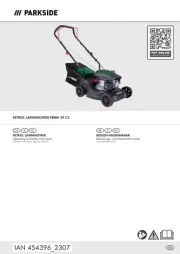
18 Juni 2025
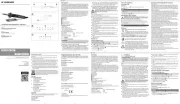
18 Juni 2025
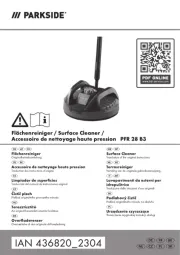
18 Juni 2025
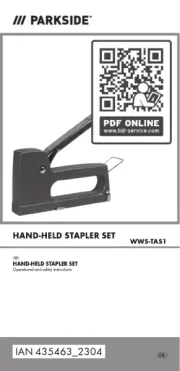
18 Juni 2025
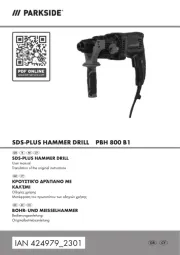
17 Juni 2025
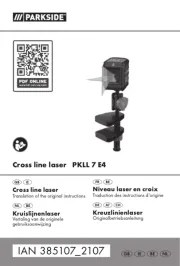
17 Juni 2025
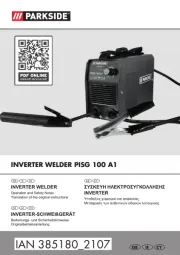
17 Juni 2025
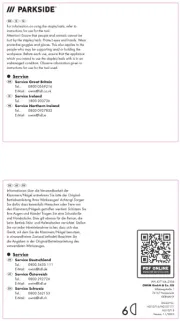
17 Juni 2025

17 Juni 2025
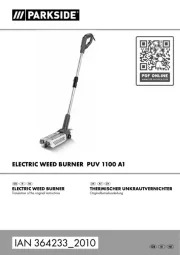
17 Juni 2025
Bedienungsanleitung Nicht kategorisiert
- Elgato
- Advance
- Waterstone
- Sage
- PCE Instruments
- Plugwise
- Basetech
- Piet Boon
- Elite Screens
- Revo
- Proaim
- Sôlt
- Quadro
- Sonifex
- Pulse ShowerSpas
Neueste Bedienungsanleitung für -Kategorien-
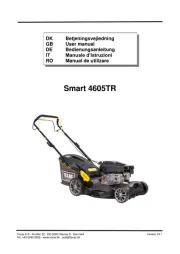
18 Juni 2025
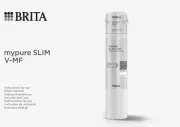
18 Juni 2025
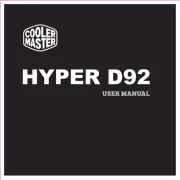
18 Juni 2025
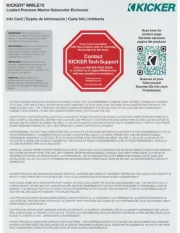
18 Juni 2025

18 Juni 2025
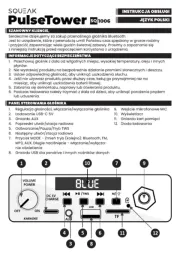
18 Juni 2025

17 Juni 2025
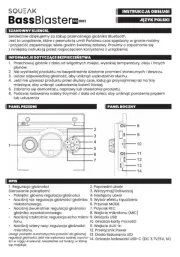
17 Juni 2025
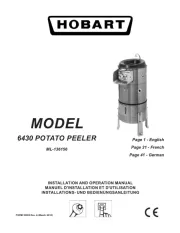
17 Juni 2025
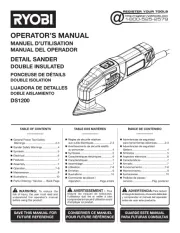
17 Juni 2025